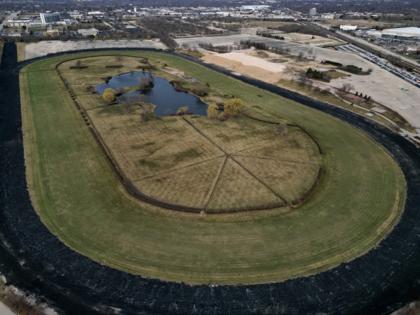A long way to go: Bears' proposed move to Arlington Heights would require complicated approval by local taxing bodies
Published in Football
CHICAGO — The Chicago Bears have submitted required traffic and financial impact studies to Arlington Heights, marking the next step in their quest to build a new football stadium there.
The studies are considered preliminary drafts that will be worked on further with a village consultant, so Village Manager Randall Recklaus declined to release them publicly for now.
But a Bears move to Arlington Heights will require much more than those plans. It will also require an extensive review by local school districts, a park district, and even, potentially, the Northwest Mosquito Abatement District.
That’s because the team agreed to a complicated process that empowers a joint review board of all taxing bodies on the former Arlington International Racecourse to approve or reject any tax deal. Which means if the Bears want a new dome, they’ll need buy-in from those groups.
“There’ll be a process that’s going to begin, and there’ll be an enormous amount of opportunity for every resident and every business owner to become educated and participate in all the dialogue that’s going to happen,” new Mayor Jim Tinaglia said at the most recent Village Board meeting. “And this entire board, believe me, will all have something to say, and it will be wonderful, or it won’t be.”
Significantly, the joint review board vote on the stadium is weighted by each agency’s share of the tax bill. That means three school districts can decide the issue, since they collect a majority of the tax burden.
As the team found out previously, getting agreement from the school districts can be difficult. At one point, the team reached an impasse with the schools, and turned its attention instead to building a stadium in Chicago.
But when state leaders rejected the notion of public funding to help pay for the Chicago site, Bears officials recently said they are shifting their focus back to the suburban site, which they own and where they can develop an entertainment district of hotels, restaurants and bars.
Late last year, the team agreed with School Districts 15, 211 and 214 on a memorandum of understanding, or MOU, that set the current property taxes for the site, and laid out the process for any future development.
The agreement set the property tax on the site at $3.6 million a year through 2027. If the Bears apply for construction and operation of an NFL stadium by the end of 2027, the property tax would extend through 2030, or until construction starts.
Most importantly, the memorandum calls for creation of a Payment in Lieu of Taxes, or PILOT, district for the area.
Such an arrangement would require state lawmakers’ approval, which the parties agreed to seek. With the spring legislative session scheduled to end Saturday, time is running out to do so immediately, which would be necessary to meet Bears President and CEO Kevin Warren’s goal to begin construction this year.
Even if the team wins state approval, what happens next would be unusual. The joint review board of all taxing bodies for the proposed PILOT district would have to agree on several issues, including a new base assessed value, and the amount of payment in lieu of taxes for years into the future.
The memorandum also calls for protections to ensure that the project would not place a financial burden on schools.
If the Bears got funding for a new stadium somewhere else, the agreement would be null and void.
For development of the 326-acre site outside of the stadium, the joint review board must recommend approval by a majority of voting members, regardless of their share of the taxes.
Even with this complicated plan, neighboring municipalities were left out.
Rolling Meadows, for instance, borders the former racetrack site on three sides. Mayor Lara Sanoica supports the Bears coming, but said any development will have to accommodate the people who live across the street.
One concern is the specific location and orientation of the stadium, and the noise that would be generated not only by football games, but by concerts, monster truck shows and other potential events. While the Bears have proposed an enclosed arena, their drawings for the facility in Chicago showed one open-air wall.
To address such concerns, the Rolling Meadows council Tuesday was expected to approve contracts with an acoustic consultant, as well as traffic engineers and Liz Brown-Reeves Consulting, a lobbyist in Springfield.
When the site was a horse racetrack, Rolling Meadows provided emergency police and fire services. Any future added costs from emergency responders and public works would have to be compensated, the mayor said.
She expected Arlington Heights officials to work with neighboring municipalities, as they’ve said they would.
“The financial impact is centrally important to us,” Sanoica said. “I’m very optimistic this is going to be a financial net benefit not just for Rolling Meadows, but the region as a whole.”
Some Arlington Heights residents do not share her optimism.
One survey by a self-described local Libertarian group opposed to stadium subsidies found that residents were happy to have the team come, but did not want to help pay for it.
The Bears have said they would pay for the stadium themselves, originally pegged at a cost of $2 billion, but would need help paying for new infrastructure, such as utilities and new roads in and out of the site.
Arlington Heights resident Keith Moens told the Village Board that they should make sure any deal provides for the village’s many needs.
“We’re in the driver’s seat as a village right now,” he said. “This is an opportunity to negotiate even more funds for education, for desperately needed available and affordable housing, for infrastructure investment, for public works, for public health and for safe streets — all in exchange for the massive property tax subsidies that will be given to the Bears later on.”
Team officials declined to comment, but when the Chicago Tribune reported earlier this month that they would shift focus to Arlington Heights, the team issued this statement: “Over the last few months, we have made significant progress with the leaders in Arlington Heights, and look forward to continuing to work with state and local leaders on making a transformative economic development project for the region a reality.”
©2025 Chicago Tribune. Visit chicagotribune.com. Distributed by Tribune Content Agency, LLC.







Comments